Your product photos are in multiple folders. Videos live on someone’s laptop. Nobody is 100% sure which hero image is approved. When you’re launching campaigns across Shopify, marketplaces, email, and social, it can turn into slow work, mistakes, and duplicated effort.
Digital Asset Management (DAM) software solves that by giving eCommerce teams a central repository to manage digital assets—product images, videos, and other files—along with workflows for approvals, version control, and secure sharing across digital channels.
Quick Overview
| What you want to know | Quick answer |
|---|---|
| What is DAM? | A digital asset management system is a searchable centralized repository for product photos, videos, and brand files—with metadata tags, version control, approvals, access controls, and integrations. |
| Why eCommerce needs it | Because multi-channel content moves fast, and folders don’t prevent duplicates, wrong versions, or brand drift. |
| Who needs DAM | Usually: 1,000+ SKUs, 2+ channels, 6+ people touching assets, or frequent promos/seasonal swaps. |
| Biggest day-to-day wins | Faster asset access, fewer mistakes, consistent brand visuals, smoother collaboration, more reuse. |
| Key benefits | Centralized assets, metadata tags + search, version control, brand consistency, rights/permissions management, and integrations with content management systems. |
| What to look for (2026) | Search at scale, SKU-first metadata, “Approved-only” workflows, permissions, rights lifecycle, Shopify/CMS integrations, automation/AI where it helps. |
| ROI | Time saved + fewer recreated assets usually pays back within months. (Calculator below.) |
What is DAM?
A digital asset management platform is a centralized library for digital assets—product images, videos, design files, and brand materials—organized with metadata tags, searchable at scale, and controlled with permissions.
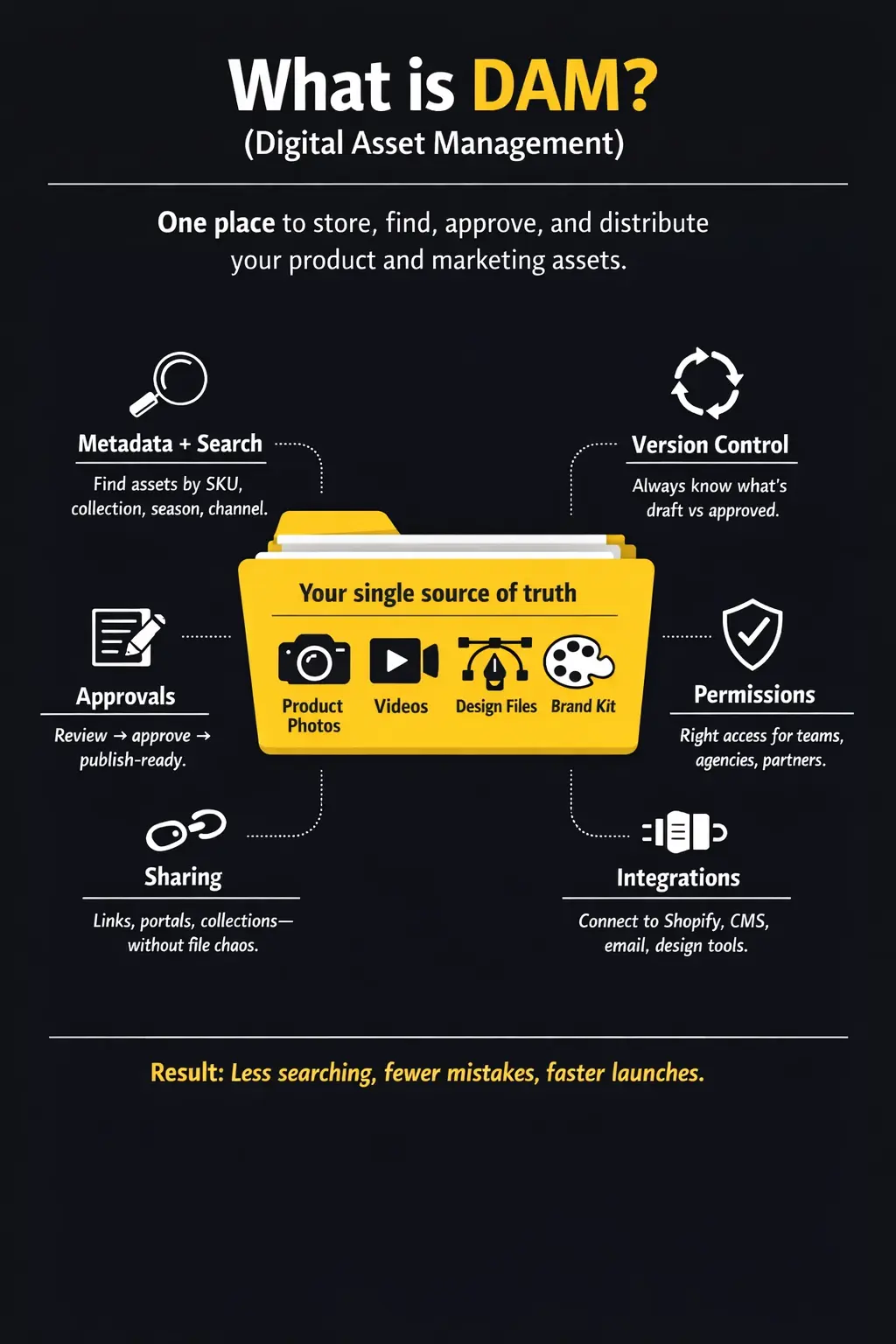
Think of it as a DAM system built for fast content workflows across multiple marketing channels. A good DAM typically includes:
- Metadata and fast search (SKU, collection, season, channel, rights, etc.);
- Version control (drafts, approved, archived; full history);
- Permissions (who can upload, edit, download, delete);
- Approval workflows (review, approve, publish-ready);
- Sharing (links, portals, partner access);
- Integrations (Shopify/CMS/email/design tools).
Why eCommerce Businesses Need DAM
In eCommerce, content is everywhere. It’s the product page, the ad, the email, the marketplace listing. When marketing materials and media assets are spread across drives, chats, and personal folders, the work slows down in predictable ways: people can’t find files, teams redo work, and the wrong version goes live.
What a DAM changes in practice:
1) Fast access to assets and centralized storage
Your team finds the right file by SKU/collection/season/channel in seconds—without asking around or creating duplicates.
2) Faster marketing execution
Campaigns move quickly when assets are already organized, approved, and ready to be exported to specific channels.
3) Brand consistency across all channels
Approved logos/templates are easy to access; outdated assets are archived so teams can maintain brand consistency across channels.
4) Better collaboration and role control
Clear permissions and access controls, review comments in one place, and an obvious “Approved” status before anything gets published.
5) Higher content quality and easier reuse
Reuse becomes simple, and teams stop settling for “whatever we found first.”
Who Needs DAM?
If you check 2 or more, a digital asset management solution usually pays off quickly for eCommerce teams and marketing teams.
Catalog size
- 500–1,000 SKUs: DAM starts to help (especially with variants and heavy visuals);
- 1,000–5,000 SKUs: folders start breaking down fast;
- 5,000+ SKUs: DAM is typically infrastructure.
Channels
- 1 channel (Shopify only): strong folder discipline can work;
- 2–3 channels: DAM becomes valuable;
- 4+ channels / partners / locales: DAM becomes critical.
Scalability is critical if your catalog grows quickly or your asset volume spikes seasonally (holiday campaigns, new collections, marketplace expansion). A DAM should stay fast with tens of thousands of assets—and keep search, permissions, and approvals reliable as more people join the workflow.
Team and contributors
- 3–5 people: manageable, but friction grows;
- 6–15 people + agencies/freelancers: DAM is usually worth it;
- Any external partners needing assets: portals/access control become a big win.
Operational “symptoms”
If these happen weekly, you’re already paying the “DAM tax”:
- “Which version is approved?” keeps coming up;
- People recreate assets because they can’t find them;
- Wrong visuals go live (even occasionally);
- You rely on one person who “knows where everything is”.
Key Benefits of DAM for eCommerce
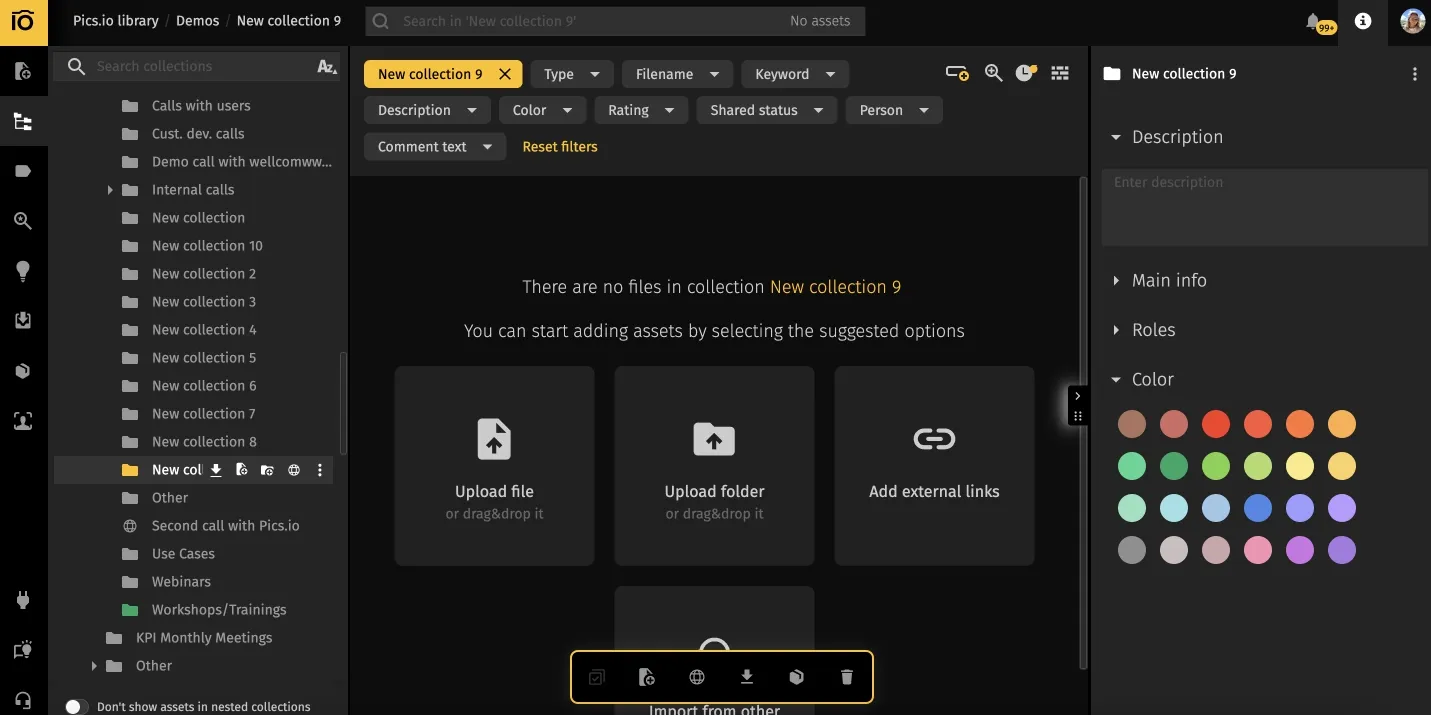
1) Centralized asset library
What it means: One centralized hub (central repository) for all product and marketing assets.
Example: A store with 8,000 SKUs keeps product imagery, lifestyle photos, and campaign banners in one DAM. When a category manager needs images for a collection refresh, they pull everything from an “Approved” library instead of chasing folders across teams.
2) Metadata & search efficiency
What it means: Find assets by the way eCommerce teams think: SKU, color, angle, season, campaign, channel, usage rights, with consistent metadata tags so relevant stakeholders can find specific assets fast.
Example: A team launching a “Back to School” campaign searches: season = BTS, product type = backpacks, status = Approved, channel = email—and instantly gets the correct set.
3) Version control
What it means: Every update is tracked. “Approved” is visible. Old versions don’t get mixed into production.
Example: A hero image goes through retouching → compliance text → final crop. The DAM shows Version 4 = Approved, so the team doesn’t accidentally publish Version 2 because it was named “final_final.”
4) Brand consistency across channels
What it means: Everyone uses the same approved logo set, templates, and product visuals—across site, marketplaces, social, and partners.
Example: A brand sells on Shopify, Amazon, and retail partner portals. Partners download assets from a portal that always contains the current approved logo and product packshots—no screenshots, no outdated brand files—so teams follow brand guidelines on every channel.
5) Security & rights management
What it means: Rights management and permissions management so the right user groups can access the right files.
Rights management features help track licenses, usage restrictions, and expiration dates for third-party assets. The best DAM systems can send automated alerts before a license expires, so teams don’t accidentally use unapproved or expired content in ads, product pages, or partner kits. This reduces the risk of costly copyright issues and last-minute campaign rework.
Example: If a brand mixes in-house photography with influencer content, stock images, and user-generated content, assets can be tagged with usage scope and expiration so they’re used only in approved channels.
6) Integration with eCommerce platforms
What it means: Connect your DAM solution to Shopify and other content management systems to reduce manual downloading and reuploading.
Example: After a new product shoot, the team uploads to DAM, tags by SKU, and pushes updated images into Shopify workflows—so product pages get updated without a week of manual file transfers.
eCommerce DAM ROI Calculator
Let’s estimate how much time and money eCommerce teams lose when asset management relies on folders instead of a DAM system—and what efficient management looks like with DAM.
Top DAM Features to Look for in 2026
When you compare DAM tools (or any DAM software) for eCommerce, prioritize the features that protect speed, accuracy, and brand consistency.
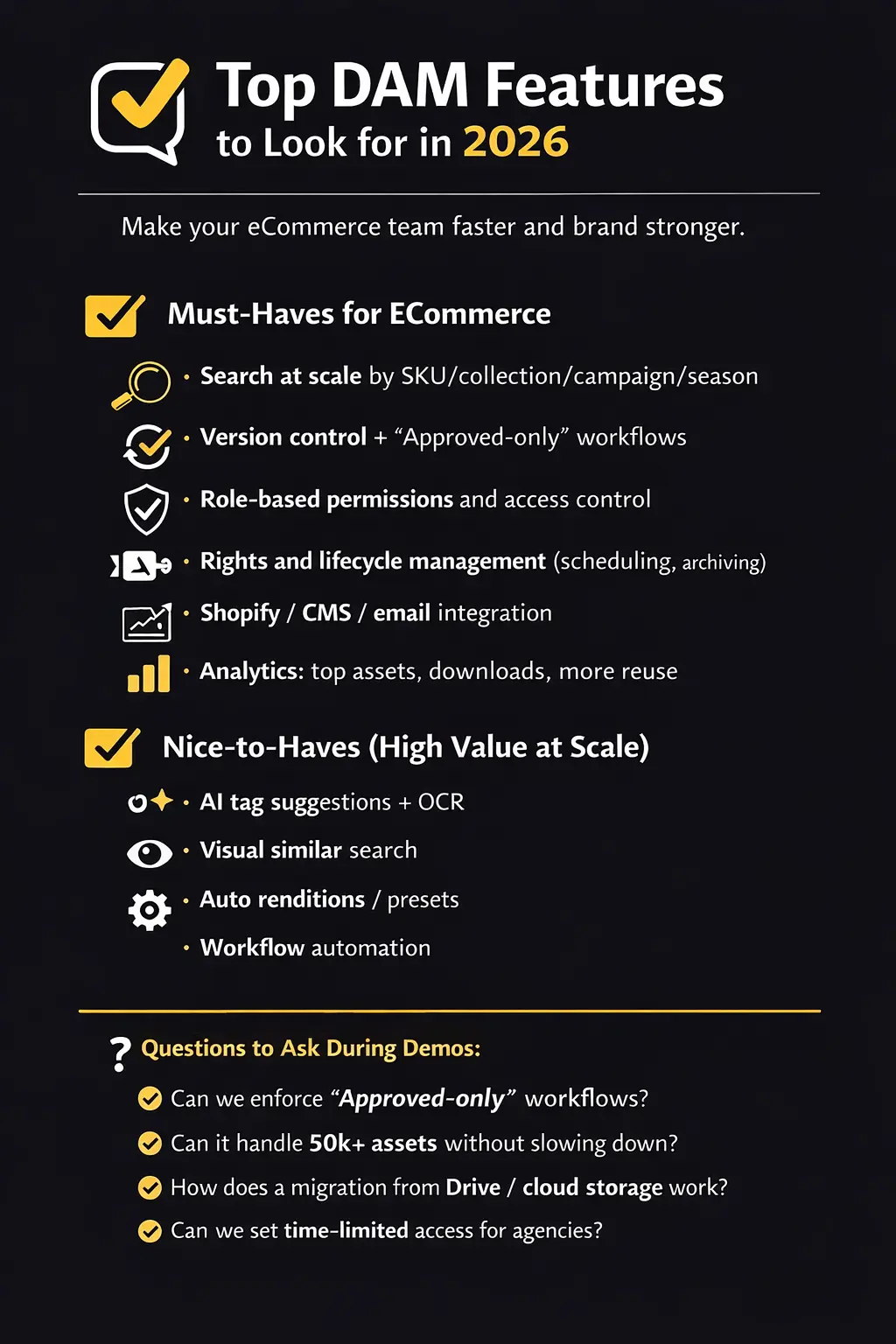
Must-haves for eCommerce
- Search and filters that scale (SKU, collection, channel, season, status);
- Custom metadata + bulk edits (SKU-first workflows matter);
- Version control + clear “Approved” state;
- Role-based permissions + folder/collection access;
- Easy sharing (links, collections, ideally partner portals);
- Rights/lifecycle basics (expiration/archiving at minimum);
- For larger teams, governance matters: you’ll want clear access controls, activity logs, and reporting that shows who uploaded, approved, shared, or downloaded assets;
- Integrations or API that fit your stack (Shopify/CMS/email/design).
Some DAM solutions are integration-first, designed to plug into an existing marketing technology stack. That’s ideal if you already rely on Shopify, a CMS, email tools, and design software—and want assets to move through your system with fewer manual steps.
Nice-to-haves (high value as you scale)
- AI tag suggestions / OCR (helps discovery, not a replacement for taxonomy);
- Visual similarity search;
- Automated renditions / export presets (channel-specific sizes/crops);
- Workflow automation (routing approvals, notifications);
- Analytics (downloads, reuse, top assets, unused assets).
Questions to ask during demos
Before you evaluate vendors, list your team’s top asset challenges (search time, wrong versions going live, partner sharing, rights tracking, or multi-channel exports). That shortlist makes it easier to identify the DAM functionalities you actually need—and avoid paying for features that won’t change your daily workflow.
- Can we enforce “Approved-only” for publishing workflows?
- How fast is search with 50k+ assets and real metadata filters?
- How does it handle SKU-based organization and bulk tagging?
- What’s the migration workflow (CSV mapping, duplicates, history)?
- Can we give time-limited access to agencies and partners?
- How do you handle archiving/expiration for seasonal campaigns?
Vendor evaluation takes time, so plan to test 2–3 solutions via a free trial (or pilot). Use real assets, real metadata (SKU/season/channel), and one real workflow (e.g., campaign launch) to see what breaks before you commit.
Best Practices for eCommerce DAM Implementation
A DAM improves workflows only when it matches how your team actually works. Map your current process first (upload → review → approve → publish → archive), then configure roles, metadata, and rules around it. Otherwise, you risk creating a new system that adds friction instead of removing it.
1) Define metadata (start small)
Start with what you’ll use weekly:
- SKU/ product name;
- Collection/ season;
- Channel;
- Asset type;
- Status (draft/approved/archived);
- Rights/ license (if relevant).
Keep required fields to a minimum to simplify adoption.
2) Organize structure and permissions
- Keep navigation intuitive (product vs marketing vs brand vs archive);
- Use permissions to reduce risk (not everyone should delete masters);
- Make “Approved” assets easy for publishing roles to access.
3) Integrate where it matters most
Start with the workflows that cause the most pain:
- Shopify/CMS asset usage;
- Email platform access to approved assets;
- Creative tools if your designers need direct access.
4) Train teams and set rules that people will follow
- Short role-specific training (marketing vs design vs eComm ops);
- Clear rule: “Publish-ready assets live in the DAM as Approved.”
- Identify 1–2 “DAM champions” who keep standards consistent.
5) Measure success with a few KPIs
- Time to find assets;
- % of publishing downloads from “Approved”;
- Asset reuse rate;
- Duplicates over time;
- Mistakes caught (wrong version, off-brand usage).
How DAM Pics.io Improves the Workflow of Real Businesses
If you’re wondering what “better asset management” looks like in practice, these stories make it concrete.
They show how eCommerce teams reorganized their media libraries around a single DAM platform, structured metadata (often SKU-first), and easier ways to share digital assets. Then saved time in the exact workflows that slow teams down the most.
Kavak: faster search + easier external sharing at scale
Kavak is a global eCommerce company selling pre-owned vehicles across multiple countries. Their marketing team (around 60–70 people) needed a better way to find and approve assets without paying extra storage fees.
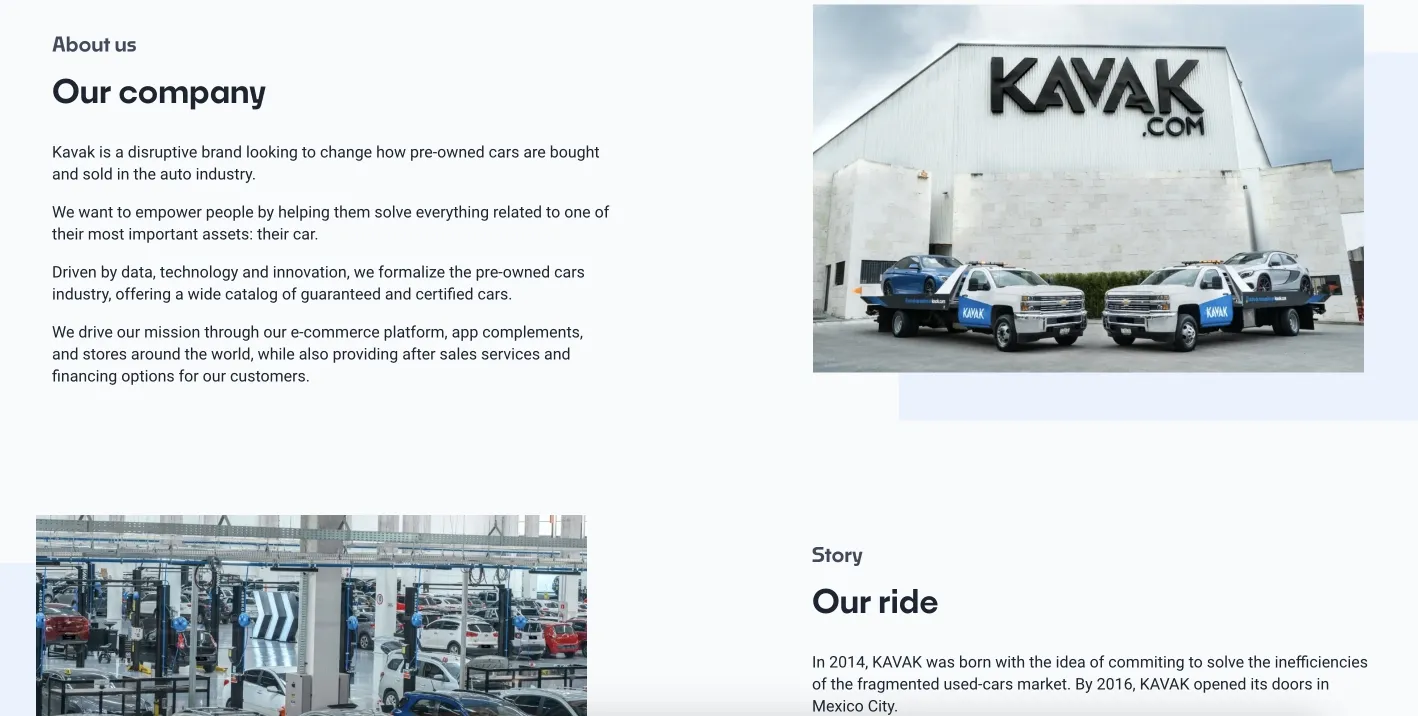
They chose a DAM that runs on Google Drive, then relied heavily on keywords for discovery and custom fields for approvals. For external sharing, they used shareable portals instead of struggling with Google Drive links. The biggest impact: they went from spending up to about an hour searching to finding assets “almost instantly,” and estimated they were saving around eight hours per week per person.
Printful: metadata-first library for 350–400K photo/video files
Printful runs a large photo/video operation and manages a library of roughly 350–400,000 files. They needed flexible keywording and ratings, while still working with original raw formats. Their workflow starts in Lightroom (including star ratings), and those ratings/keywords carry into the DAM on upload, making content searchable immediately.
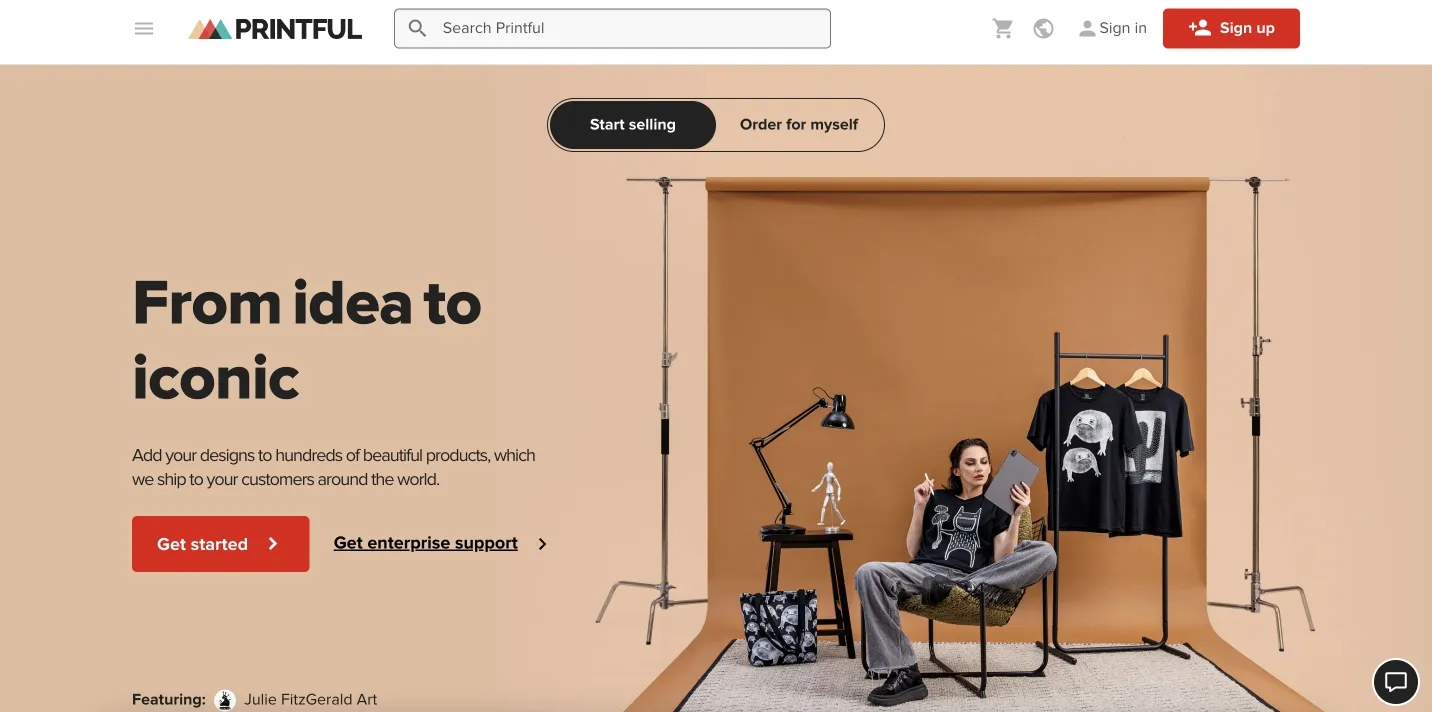
They also use comments for review discussions directly on assets, and sharing portals to distribute content to internal users without seats and to external clients. One practical win: DAM Pics.io saves hours per photoshoot and makes it faster to locate and archive content when products are discontinued—without having to check multiple storage locations.
Hudson Valley Seed Company: “from no system to searchable” for catalog and marketing
Hudson Valley Seed Company sells seeds and related products and has accumulated years of photos and digital content with no real organization system. The pain was simple: when they needed images for marketing or their catalog, they struggled to locate them, and collaboration was limited.

They implemented DAM on top of Google Drive, built a custom metadata/tagging scheme, and centralized access for the team. The result: when they need an image, they can find it immediately, saving at least a few hours per month and making day-to-day marketing work far less chaotic.
Tumble: influencer-heavy content and “find the right visual” for ads
Tumble is a DTC rug brand with 300+ designs and sizes and a steady stream of new photo/video content from an influencer program. As complexity grew, they needed a way to quickly identify the right assets for ads, email, and ongoing campaigns (e.g., “this rug design in this room type”).
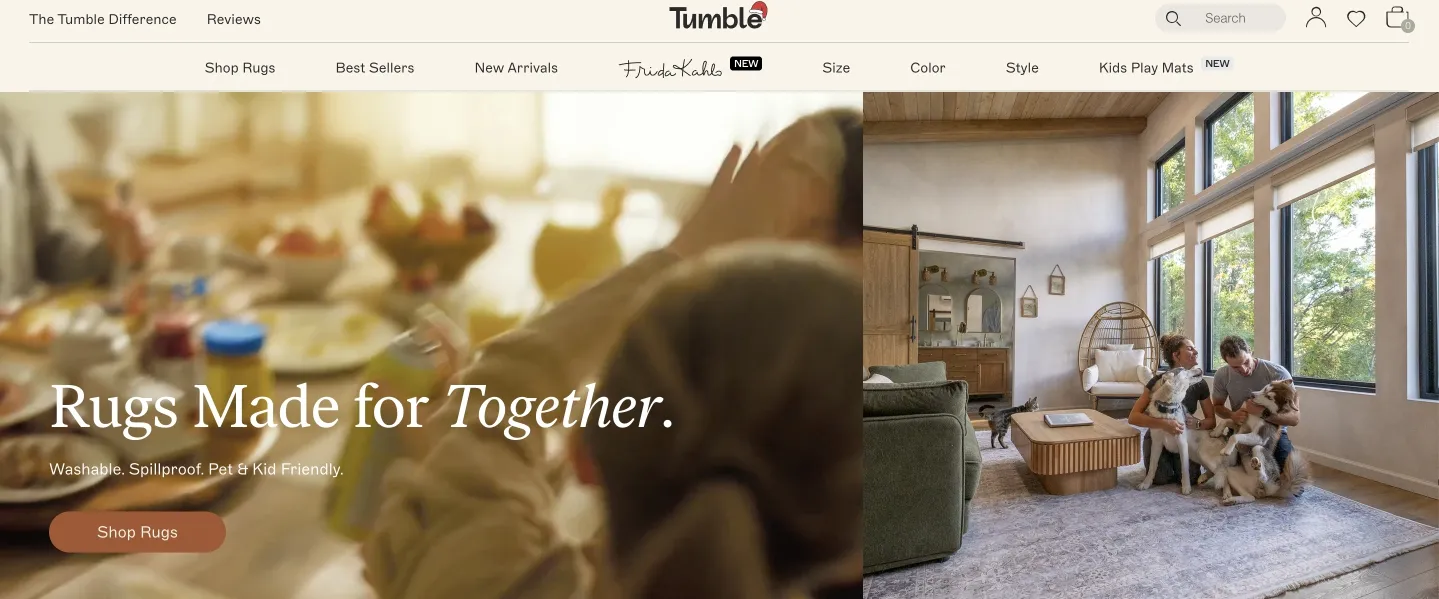
They picked DAM Pics.io because it could sync with Google Drive, then used custom fields to build filters that match how the team searches. They also give selective access to agency partners by collections, use shareable portals for bundling assets, and tag/filter video content; they even use speech-to-text transcription to make videos easier to search. Their marketing lead estimates it saves a few hours per month compared to scrolling through folders.
Conclusion
DAM is how you keep assets consistent, approvals clear, and launches fast—without burning team time on searching and rework.
For eCommerce teams handling hundreds (or thousands) of SKUs, frequent promos, and multiple channels, DAM typically pays for itself through time saved, fewer mistakes, and higher reuse of content you already paid to create.
FAQ
Is DAM just Dropbox/Google Drive with folders?
No. Storage holds files. DAM adds metadata, search, approvals, versioning, permissions, rights, and workflow controls.
Do small stores need DAM?
If you have a small catalog and one channel, you can often live without it. Once you add channels or external contributors, DAM becomes more important.
Can DAM work with Shopify?
Many DAMs integrate with Shopify via apps, connectors, or API. Validate the exact workflow you need (SKU mapping, syncing, export presets).




